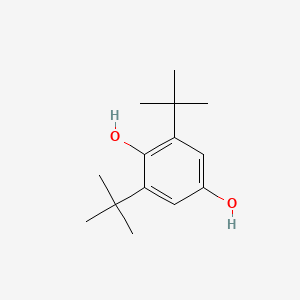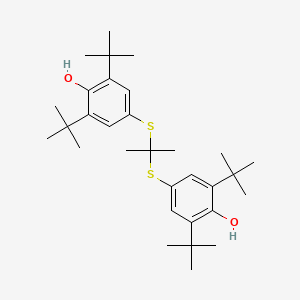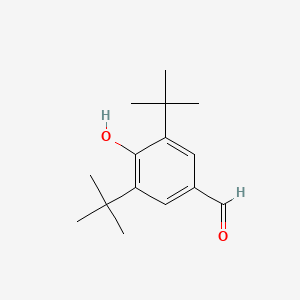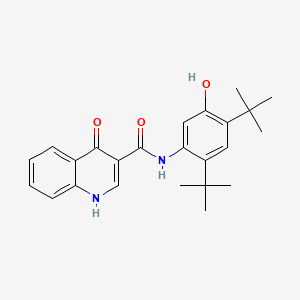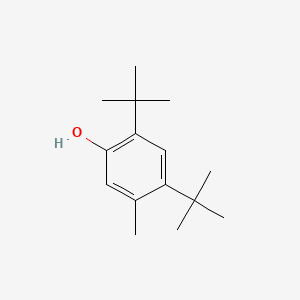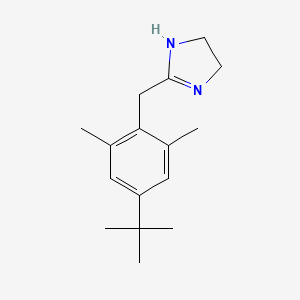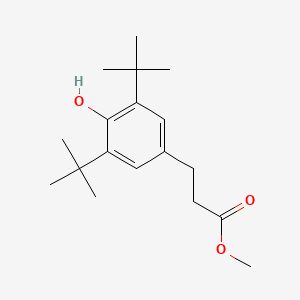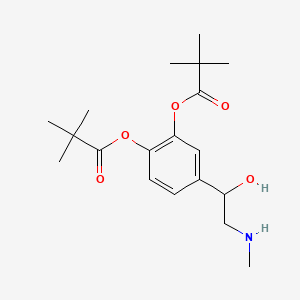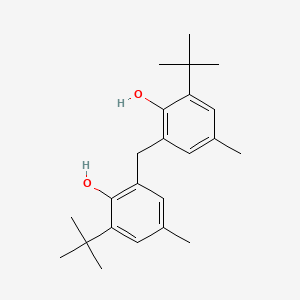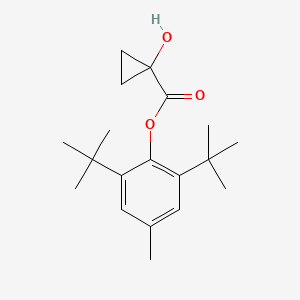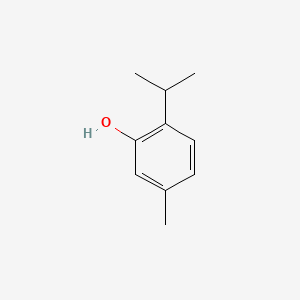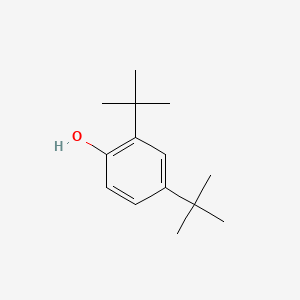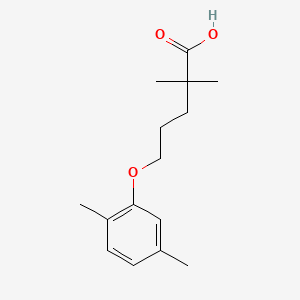| Synonyms |
2,6-Di-tert-butyl-4-methylphenol; 128-37-0; Butylhydroxytoluene; 2,6-Di-tert-butyl-p-cresol; 2,6-Di-t-butyl-4-methylphenol; Ionol; BHT; DBPC; Dibunol; Stavox; Ionol CP; Phenol, 2,6-bis(1,1-dimethylethyl)-4-methyl-; Impruvol; Kerabit; Topanol; Dalpac; Deenax; Ionole; Vianol; Antioxidant KB; 3,5-Di-tert-butyl-4-hydroxytoluene; 2,6-ditert-butyl-4-methylphenol; Antioxidant 4K; Sumilizer BHT; Topanol O; Topanol OC; Vanlube PC; Antioxidant DBPC; Sustane BHT; Tenamene 3; Vanlube PCX; Antioxidant 29; Antioxidant 30; Nonox TBC; Tenox BHT; Chemanox 11; Ionol 1; Agidol; Catalin CAO-3; Advastab 401; Ionol (antioxidant); BUKS; Parabar 441; Paranox 441; 2,6-Di-tert-butyl-4-cresol; Catalin antioxydant 1; Antrancine 8; Vulkanox KB; Di-tert-butyl-p-cresol; 2,6-Bis(1,1-dimethylethyl)-4-methylphenol; Ional; AO 4K; CAO 1; CAO 3; Di-tert-butyl-p-methylphenol; FEMA No. 2184; o-Di-tert-butyl-p-methylphenol; 4-Methyl-2,6-tert-butylphenol; 2,6-Di-tert-butyl-1-hydroxy-4-methylbenzene; 2,6-Di-tert-butyl-p-methylphenol; AO 29; NCI-C03598; 2,6-ditert-butyl-4-methyl-phenol; 2,6-DI-T-BUTYL-P-CRESOL; 4-Methyl-2,6-di-tert-butylphenol; Butyl hydroxy toluene; 2,6-Di-terc.butyl-p-kresol; 4-Hydroxy-3,5-di-tert-butyltoluene; P 21; Bht(food grade); 4-Methyl-2,6-di-terc. butylfenol; 2,6-Di-tert-butyl-4-methyl-phenol; 1-Hydroxy-4-methyl-2,6-di-tert-butylbenzene; Di-tert-butylcresol; Dbpc(technical grade); E321; p-Cresol, 2,6-di-tert-butyl-; NSC-6347; CHEMBL146; 2,6-ditertiary-butyl-p-cresol; INS NO.321; CHEBI:34247; INS-321; 1P9D0Z171K; 2,6-di-tert-butyl-4-methyl phenol; NCGC00091761-03; Tonarol; DSSTox_CID_216; Antioxidant MPJ; E-321; Antioxidant 4; Toxolan P; Alkofen BP; Swanox BHT; Tenamen 3; Antox QT; Antioxidant 264; DSSTox_RID_75440; Agidol 1; DSSTox_GSID_20216; Bht (food grade); Antioxidant T 501; Nocrac 200; Caswell No. 291A; Dbpc (technical grade); Annulex BHT; AOX 4K; AOX 4; Butylhydroxytoluenum; MFCD00011644; CAS-128-37-0; Butylohydroksytoluenu; CCRIS 103; Butylohydroksytoluenu [Polish]; Ionol CP-antioxidant; Di-tert-butyl-p-cresol (VAN); HSDB 1147; BHT 264; NSC 6347; EINECS 204-881-4; 2,6-Di-terc.butyl-p-kresol [Czech]; EPA Pesticide Chemical Code 022105; 2,6-Di-tert-butyl-4-methylhydroxybenzene; Popol; UNII-1P9D0Z171K; AI3-19683; 4-Methyl-2,6-di-terc. butylfenol [Czech]; Lowinox BHT; Nipanox BHT; BHT Swanox; BHT, food grade; 4-Methyl-2,6-di-t-butyl-phenol; Ionol BHT; Ralox BHT; 2, food grade; 3IM; Dibutyl-para-cresol; 2,6-bis(tert-butyl)-4-methylphenol; Spectrum_001790; BHT FCC/NF; SpecPlus_000768; Methyldi-tert-butylphenol; Spectrum3_001849; Spectrum5_001612; BHT [INCI]; Hydagen DEO (Salt/Mix); BHT [FCC]; EC 204-881-4; 2,6-di-Butyl-para-cresol; 2.6-di-t-butyl-p-cresol; SCHEMBL3950; 2,6-ditert-butyl-p-cresol; p-Cresol,6-di-tert-butyl-; Di-tert-Butylparamethylphenol; BSPBio_003238; KBioSS_002281; 2,6-di-tert.butyl-p-cresol; Di-tert-Butyl-4-methylphenol; MLS000069425; BIDD:ER0031; DivK1c_006864; SPECTRUM1600716; 2,6-bis-tert-butyl-p-cresol; 2,6-di-tert-butyl-paracresol; 2,6-di-tert. butyl-p-cresol; 2,6-di-tert.-butyl-p-cresol; 2,6-di-tert-butyl-para-cresol; 2,6-di-tert-Butyl-methylphenol; 2,6-ditertbutyl-4-methylphenol; DTXSID2020216; 2,6-di-t butyl-4-methylphenol; 2.6-di-t-butyl-4-methylphenol; FEMA 2184; KBio1_001808; KBio2_002280; KBio2_004848; KBio2_007416; KBio3_002738; 2,6-di-tert-butyl-4-methylenol; 2,6-di-tert-butyl-4methylphenol; 2,6-di-tert-butyl4-methylphenol; 2,6-di-tertbutyl-4-methylphenol; 2,6-ditert.butyl-4-methylphenol; NSC6347; 2,6-Di(tert-butyl)hydroxytoluene; 2,6-di(t-butyl)-4-methylphenol; 2,6-di-t- butyl-4-methylphenol; 2,6-di-t-butyl 4-methyl phenol; 2,6-di-t-butyl-4-methyl phenol; 2,6-di-t-butyl-4-methyl-phenol; 3,5-di-t-butyl-4-hydroxytoluene; HMS2091E21; HMS2231M22; HMS3369G17; HMS3750M21; Pharmakon1600-01600716; 2,1-dimethylethyl)-4-methylphenol; 2,6-di-tert-butyl 4-methylphenol; 2,6-di-tert-butyl-4 methylphenol; 2,6-di-tert-butyl4-methyl phenol; 2,6-di-tert.butyl-4-methylphenol; 2,6-ditert.-butyl-4-methylphenol; 2.6-di-tert-butyl-4-methylphenol; 4-methyl-2,6-di-tert.butylphenol; 2,6-di-ter-butyl-4-methyl-phenol; 2,6-Di-tert.-Butyl4-methylphenol; 2,6-ditertiarybutyl-4-methylphenol; 2.6-di- t-butyl- 4-methylphenol; AMY40200; HY-Y0172; STR04334; ZINC1481993; 2,6 -di-tert-butyl-4-methylphenol; 2,6-di(tert-butyl)-4-methylphenol; 2,6-Di-tert-butyl-p-cresol, 8CI; 2,6-di-tert.-butyl-4-methylphenol; Tox21_113537; Tox21_201093; Tox21_303408; 2,6-di-tert-butyl-p-cresol (BHT); 2,6-Di-tert-butyl-para-methylphenol; BDBM50079507; NSC759563; s6202; STL277184; 2,6-di-tert. butyl-4-methyl phenol; 2,6-Di-(tert-butyl)-4-methylphenol; AKOS000269037; Tox21_113537_1; CCG-207937; CS-W020053; NSC-759563; Phenol, 2,6-di-tert-butyl-4-methyl-; NCGC00091761-01; NCGC00091761-02; NCGC00091761-04; NCGC00091761-05; NCGC00091761-06; NCGC00091761-07; NCGC00257275-01; NCGC00258645-01; AC-10553; BUTYLHYDROXYTOLUENE [EP MONOGRAPH]; SMR000059076; 2,6-Di-tert-butyl-4-methylphenol, 99%; BUTYLHYDROXYTOLUENUM [WHO-IP LATIN]; SBI-0052890.P002; 2,6-Di-tert-butyl-4-methylphenol, >=99%; D0228; FT-0610731; Phenol,6-bis(1,1-dimethylethyl)-4-methyl-; 2,6-bis-(1,1-dimethylethyl)-4-methylphenol; 4-Methyl-2,6- di(1,1-dimethylethyl)phenol; 4-METHYL-2,6-DITERTIARY-BUTYL-PHENOL; EN300-52982; PK04_181024; 2,6-Di-tert-butyl-1-hydroxy-4-methyl benzene; D02413; D77866; MLS-0146297.0001; AB00053233_09; Phenol, 3,5-bis(1,1-dimethylethyl)-4-methyl-; 2,6-Bis(1,1-dimethylethyl)-4-methylphenol, 9CI; 2,6-Di-tert-butyl-4-methylphenol, puriss., 99%; A937188; AC-907/25014329; Q221945; SR-01000735918; SR-01000735918-2; W-108376; 9FC4DFC8-480D-487C-A74A-2EC9EECE92C4; BENZENE,1,3-DITERT.BUTYL,2-HYDROXY,5-METHYL; BRD-K53153417-001-01-3; BRD-K53153417-001-06-2; 2,6-D[(CH3)3C]2C6H2(CH3)OHi-tert-butyl-p-cresol; F0001-0395; Z764922868; 2,6-Di-tert-butyl-4-methylphenol, purum, >=99.0% (GC); WLN: 1X1 & 1 & R BQ E1 CX1 & 1 & 1; 2,6-Di-tert-butyl-4-methylphenol, >=99.0% (GC), powder; 2,6-Di-tert-butyl-4-methylphenol, SAJ first grade, >=99.0%; 2,6-Di-tert-butyl-4-methylphenol, tested according to Ph.Eur.; 3,5-Di-tert-4-butylhydroxytoluene (BHT), analytical standard; 2,6-Di-tert-butyl-4-methylphenol 1000 microg/mL in Acetonitrile; Butylhydroxytoluene, European Pharmacopoeia (EP) Reference Standard; 2,6-Di-tert-butyl-4-methylphenol, certified reference material, TraceCERT(R); 2,6-DI-TERT-BUTYL-P-CRESOL2,6-BIS(1,1-DIMETHYLETHYL)-4-METHYL-PHENOL
|

